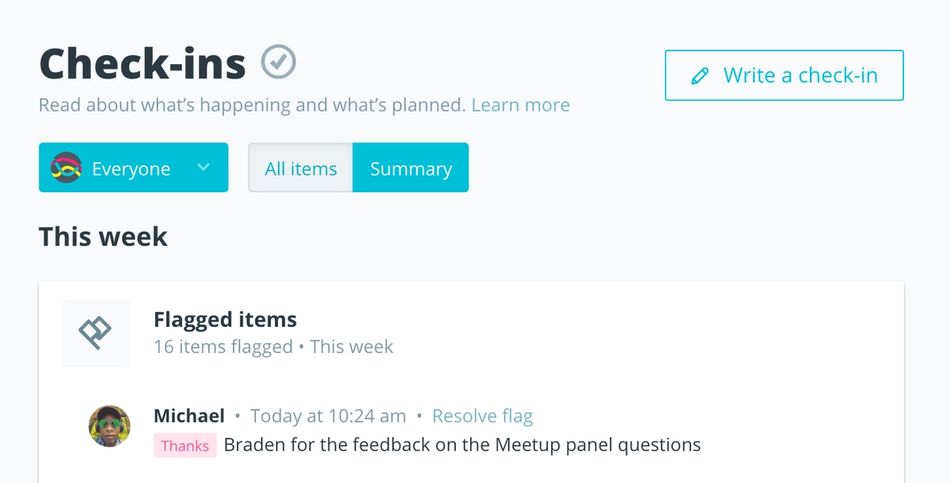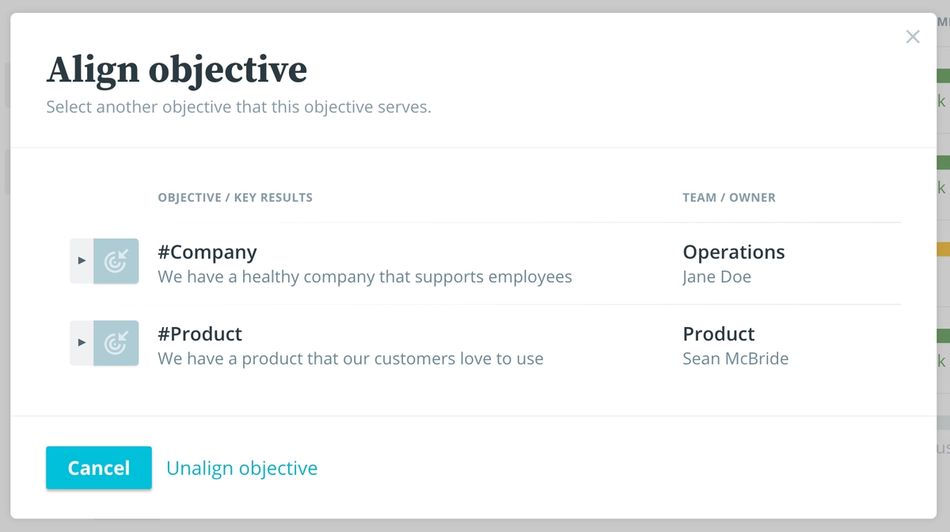
For managers and teams, getting your remote strategies right takes practice and an open mind. How do you keep people in multiple locations and time zones on the same page? What ways can you strengthen team culture and keep everyone connected? How should you structure your work week? How do you set goals and collaborate best when you're apart? And are there tools that could make this transition smoother?
We've put together this module to help you answer questions like these and to understand how to best use Range to make your remote teams successful.
But first, if you’re new to Range, be sure to check out Getting Started with Range.
What's in this article?
- Cadence
- Effective Communication
- Company Alignment
- Culture

Cadence 🔁
Your cadence is a set of rhythmic activities that help you get work done. For example, checking your email every morning or sharing a weekly performance update with your colleagues are things you do as a part of a cadence. It's a set of behaviors and routines that provide structure, focus, and predictability.
A common pain point for people working remotely is feeling disconnected from what they should be working on and why. In situations where things change quickly and often, this problem can get even worse. The absence of both opportunities to share and well-documented, consistent practices can lead to a lack of direction and confusion.
Establishing a cadence solves this by:
- Keeping your team focused with touch points throughout a project.
- Making sure everyone understands when to work on what.
When you define a cadence for your team, you’ll see big benefits in both performance and well being.
It’s natural for this to change over time with distributed teams and flexible work schedules. Organizations often conflate a ‘work day’ with being in the same place at the same time—the result of transferring over traditionally co-located workspaces to remote ones. But being on the same time table or in the same location is not the same as being productive.
How to build a cadence
Most teams we’ve spoken to have defined project cycles. Defining work in blocks can help with prioritization and focus. You’re clear on what you want to get done over a set period. For example, you can use a two week work “cycle.”
Once you define your cycle, then determine the right types of meetings and the timing. For example:
- Most cycles start with a team kick off meeting to discuss the focus of the next few weeks.
- And the cycle ends with a wrap up discussion of what got done.
- You should also schedule time between kickoff and wrap for the team to collaborate—two or three sessions are a good start.
A cadence helps you cut back on random, unfocused face time, especially when you use Range for status updates and daily check-ins. Remote employees benefit from this type of regular, non-intrusive interaction. This approach empowers people to structure their days and work in a way that keeps the project moving forward.
Tip: work in shorter cycles when remote work is involved. The rapid turnaround time fosters focus but leaves room for flexibility. Your team will need both to make up for the various work from home setups.
Here’s a worksheet to help you map out the right cycle.
How to approach remote meetings
Once you’ve defined the right meetings, you can set them up in Range. Some groups use Range for all of their meetings, others use it for the primary ones that involve the whole team, such as the kickoffs, collaborations sessions, and cycle recap.
Some tactics to consider:
- Use the spinner at the beginning to make sure everyone has a chance to speak. It helps make meetings inclusive and keeps everyone engaged.
- Decide on a facilitator for each meeting (possibly with a round robin system).
- Set recurring agenda items as necessary, but also leave time to build an agenda during the meeting. Agenda items follow the meeting until they get checked off.
- Review cycle goals at the kickoff and the recap. Remember, you can save outstanding issues for the next meeting.
- Because all meeting notes are shared with the whole team, even if someone can’t take part due to a scheduling conflict or time zone difference, they can still know what was discussed
Here’s an overview of how to Get Started with Range for meetings and 6 tips for running more productive remote meetings.
Tip: Whether it's your all-hands meeting, check-ins, or 1:1s, it can be really helpful to have a shared document that details how to best run each meeting and what’s expected of each participant.
Having a cadence helps with:
- Alignment on priorities
- A sense of progress
- A sense of belonging
- Accountability
How to get your cadence down
Remote teams use Check-ins as a key way to stay in sync and keep the work moving in the right direction. When you have a defined cadence, it helps teams better clarify and organize. When everyone develops the habit of doing a Check-in, the team knows who’s making progress and who’s blocked, no matter how far apart they are.
Be sure to read this article about how to write your weekly Check-in.
Setting clear objectives is the way to stay aligned during each cycle, and critical to establishing the right work cycle. When you build your objectives in Range, you can:
- Easily reference and update them, then review them in the key team meetings, such as kick offs and cycle recaps.
- Use a Tag approach to Objectives, so you can reference them in both meeting notes and the activities you list in your check-ins, creating a data set that makes the cadence of work more efficient for everyone. You don’t have to go looking in multiple locations to see goals and progress.
Take a look at:
- Getting started with Objectives in Range
- What exactly are OKRs and how to do them in Range
☝️We go into more detail on the importance of objectives to remote teams in the Company Alignment section.
Once you define your cadence, it will take some cycles for everyone to get the hang of it. Make sure to get feedback from your team so you can adjust accordingly. It can help to have “cadence” as a recap agenda item for the first month or two.
Having your remote employees provide input in how you shape your cadence will help them be more engaged and invested.

Effective Communication 💬
One of the first things to break down for remote teams is communication. People can't catch up in the office kitchen or pop by someone's desk to chit chat and get a quick answer to a question. Maybe there’s an update you need to let a collaborator know about but they’re in another time zone halfway around the world. How do you do this without waiting for your next meeting or hoping they check their email before they begin work on something that may be a waste of time?
A breakdown in team communication hurts team morale, which can lead to project delays, and ultimately, teams unable to meet their goals.
There's no one size fits all communications solution. But adopting a less linear approach to communication will make the process more manageable and efficient for your remote team. There are steps and tools that will help you solve these communication issues before they arise.
Start by listing the channels your team uses for internal communication. You’ll want to define their use cases and split up your channels by synchronous and asynchronous tasks. The concepts around synchronous and asynchronous are important (especially for remote teams).
As teams go through this exercise, they often find that they have a lot of bad synchronous communication behaviors. But once they start doing more asynchronous communication to coordinate, they become much more efficient.

When we say Synchronous, we mean communication that’s instant or prompt. This type of communication, like in-person meetings, instant messages, or phone calls, is good for addressing pressing topics.
Asynchronous, conversely, is communication that’s not linear and doesn’t call for immediate attention. This is great for communicating information that can be acted on later or based on a turnaround time set by your team.
Take a standup, or scrum, meeting as an example. This is a transactional meeting meant to check in on the status of work. There’s no need to actually do them in-person, and when you switch to asynchronous communication, like using written check-ins, you save a lot of valuable in-person time. Here’s an article that goes into how to approach status updates in place of standup meetings.
Not having everyone in one room, office, or even time zone means relying on all your tools and methods to keep your organization on the same page. So getting asynchronous communication down will be essential for the success of your remote team.
How to master sync and async communication
Below is a table with examples of how you can split up your channels and how they can be used for synchronous and asynchronous communication (not exhaustive).
Your team's tools and processes will be unique to your situation, so this is mainly illustrative. You can use this as a framework to map out your tools with more granularity.
Asynchronous Channels
- Google docs
- Range
- Gmail
- Dropbox
- Github
- Asana, Trello, Confluence
Synchronous Channels
- Slack
- Video
- SMS
- In-person meetings
- Offsites
Asynchronous Communication
- In-context comments on Docs
- Product, design, copy feedback
- Assigning action items
- Project updates
- Company announcements
- Daily Check-ins & standups
Synchronous Communication
- 1:1 meetings
- All hands meetings
- Project kick offs & retros
- Socializing & memes
- Personal check-ins
- Ad hoc collaboration
Going through the process of mapping out your channels helps to clarify how your team should be using them for what purpose and helps the recipient of the message know when their attention is needed. It means fewer disruptions for non-essential matters, more focus, and the chance for people to work in a way that best suits them.
We recommend creating a shared doc that details how your team should approach each channel, and best practices for each. For example, Slack for urgent comms where you need a response fast, email for longer, less urgent communication.
How to achieve transparency at scale
Use Range to move typically more synchronous communication to async. For example, are team leads pinging people on Slack to ask for a project update? Or are you wasting time in meetings with half-finished status reports? Ask your team to use Range to report on these things non-linearly, where it's more efficient, scales better as your company grows, and creates transparency.
For managers, this can also help reduce the urge to micromanage. To learn more about how to counter micromanaging, read this article on Understanding and learning to manage your micromanaging boss.
People can also comment on items in a Check-in, provide feedback, or give a simple thumbs up in their own time. You can also flag items, such as if somethings blocked, and give thanks to highlight great work and collaboration.

Learn more about Using Flags and Thanks in your Check-in here.
Company Alignment 🤝
Your team's objectives support the fulfillment of your company's long-term purpose, but keeping everyone aligned and able to act on objectives with confidence is even harder for remote teams. How do you know if you're making progress on your goals when you’re in different places and on separate schedules? Do you have a way to know if people are working on the ‘wrong’ thing?
The implications of misalignment are numerous. From not knowing where projects are stuck or when they need attention to your team not making efficient progress and people feeling like their work doesn’t really matter. Ensuring that everyone is on the same page is paramount because it guides the progress of your team and the work everyone does.
How to get rid of the roadblocks
To counteract this potential roadblock, you need to encourage regular updates from teammates on the goals they own and clarify goals by writing them down. And make sure everyone has access so no parties have to Slack or email around to get it, delaying the process. You should also align goals to serve other goals so people understand why they're doing work.
The benefit of having your remote team aligned on objectives is that it gives people the autonomy to make decisions and do their best work. Your teammates don’t have to wait until someone is online or book a video call to decide whether their plan for the day fits with your team objectives.
If you want to learn more about setting good objectives, read here.
How to see and track objectives
Range helps teams easily see and track objectives. Teams use a hashtag system to associate check-ins and meetings with objectives. This feature also lets you connect an owner with each objective. That way, it can remind owners to update the status of objectives each week. It also gives teams the ability to tie daily tasks or projects to larger team goals.

For remote teams, once you place your objectives in Range, you can use them in a variety of synchronous and asynchronous communications. For example, reviewing them at the beginning of kick-off meetings, as well as highlighting progress or roadblocks is a good way to keep them top of mind. Or when you update objectives, everyone receives a message in email or Slack, and can view the updates when they need to.
Nurturing Remote Culture 😄
"How's it going?"
A simple question, but it's a pretty powerful one. It's commonly referred to as a belonging cue and it creates a sense of safety and openness that fuels your team culture.
When working remote, you need to be intentional about creating opportunities to renew these belonging cues.
Feeling disconnected personally from the team not only affects alignment, but can also have a huge impact on culture and people feeling out of place at your company. Not being able to know a colleagues' mood or connect with them on an individual level has a distancing effect that is detrimental to cadence, communication, and alignment.
Is someone having a bad day or do they see something differently for a cultural reason? Do you have musicians on the team? Are you a group of mostly night owls or early birds? This all relates to how people work, think, and function.
Creating opportunities to reinforce these belonging cues, though they may seem simple, will go a long way in encouraging vulnerability, connection, and trust in your team. These all form the foundation of a strong work culture, and they need to be nurtured everyday.
Below are some ideas for fostering a healthy remote culture.
Build a healthy remote culture by:
- Hosting morning video chats over coffee or tea
- Hosting optional video social hours
- Allowing everyone to personally check-in at the beginning of meetings
- Bringing everyone into the planning process
- Having regular organizational checkups to see if the system is working for the team
- Celebrating wins, birthdays, personal achievements, and more
- Encouraging flexibility and leave room for spontaneous collaboration
How to help your team feel safe and connected with Range
We’ve worked with respected behavioral psychologists to understand what goes into fostering connection and openness at work, and built features into Range to help you maintain the important ties that bind a team together.
The daily team icebreaker questions in Range are engineered to get your team talking and connecting on shared interests. “What was your favorite class in high school?” or “How do you prefer to communicate?” can help humanize individuals on teams.
If you want to use these questions outside of Check-in, for example, at the beginning of a meeting, or to wind up the week with a team social hour, we have a free Icebreaker tool that has all of the questions built in.
Asking “How are you feeling” everyday is obviously tough for remote teams, so we have mood sharing built in to help each person on your team share how they’re feeling.
Everyone can share their mood as an emoji in their Check-in. It’s a good way to convey how you’re feeling, and help you navigate the day. For example, if you realize you’re grumpy in the morning, this feature can give you a bit more perspective on how you’re approaching work and interactions with your teammates. And knowing how someone else is feeling helps you interpret their actions.
You can view your team’s mood trends, but this is only visible on team pages and email updates for teams. Other people can’t see your mood trends on your profile, apart from looking at each individual Check-in one-by-one.
Everyone’s mood is featured at the top of the Home page on Range, so you can quickly get a sense of how the team is collectively feeling every day.
As your remote team builds the habit of sharing their moods and answering questions, it will strengthen their connections, and build trust.
To better understand how to nurture your remote-team culture, take a look at An introduction to psychological safety at work and How you can build trust on your team in a few minutes a day.
Keep this in mind 📝
Remote work changes how your team collaborates. That means you need to make adjustments to a lot of your team practices. Your goal is to keep everyone on the same page. With a remote communications plan, you can avoid many of the pitfalls that can hold back productivity.
By building constructive remote habits, improving the way your team communicates, advocating for team alignment, and nurturing team culture, you're putting your team in the driver's seat on the road to success.
And to learn more about all things related to remote teams, but sure to visit the remote section of our blog.
Diving into remote work with Range
Range is free to try, and if you ever want more information or to better understand if it’s right for your team’s needs, just drop us a line at hello@range.co.








